
![]()

|
|
|
|
France
Page 4
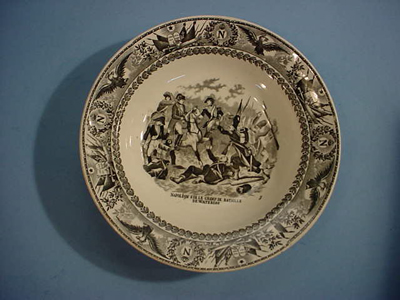
|
|
Napoleon Plate (Vive La Emperor) (Item FRAN 4-2)
|
|||
|
DESCRIPTION: This is a nice 8 ½" diameter plate depicting Napoleon and his soldiers in battle pose. Around the edges we
encounter flags, bayonets, cannon, and the crowned (N) representing Napoleon with the laurel wreath of Victory. We believe this is a decorative
collector’s plate from the turn of the century. The mark on the back is a rampant lion and the words in French or Dutch that translate to
Germanic society in Maestricht. This would indicate a specially made piece of porcelain with limited issue or perhaps unique?? PRICE: $125.00 |
|||
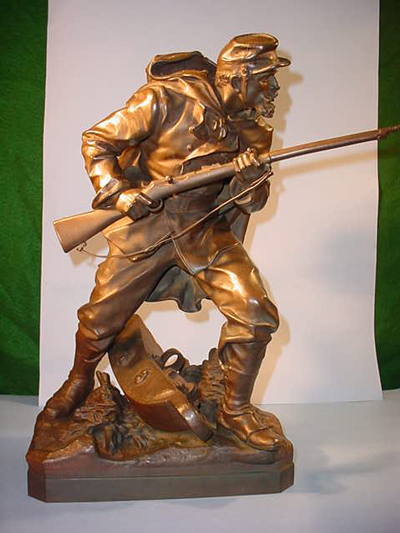
|
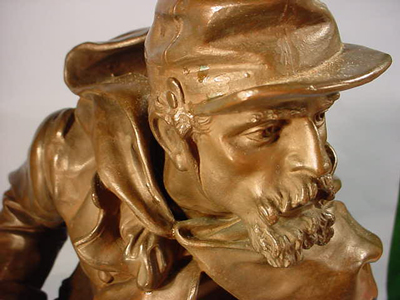
|
|
Huge Bronze Sculpture of 1870 French Soldier by Aristide Croisy (Item FRAN 4-3)
|
||||
|
DESCRIPTION: This is a monumental bronze statue by the famed sculptor Aristide Croisy born in Fagnon Ardennes. He was a pupil of the great sculptor Toussaint. He received prestigious medals of the Salon 1873, 1882, and 1885. He was honored with the Legion d’ Honor in 1885. He was a prolific artist turning out many hundred of bronze statues in his career. Some for official government sources. He was most famous for military subjects. His l’Invasion group was world famous. This was a two part set depicting a French soldier and the other part was a French sailor both at the ready with rifles. This one we offer is one of his most famous sculptures. It depicts a French 1870-period soldier foraging with rifle in hand. It is most accurate and the fine detail is wonderful. We said it is large!! Measures 20” high including the base. The rifle he holds is 16" long and the base is 8" x 12" in size. The soldier is 15 ½" high. It is signed by the artist and is very heavy! This is a true museum piece extraordinaire! PRICE: SOLD |
||||
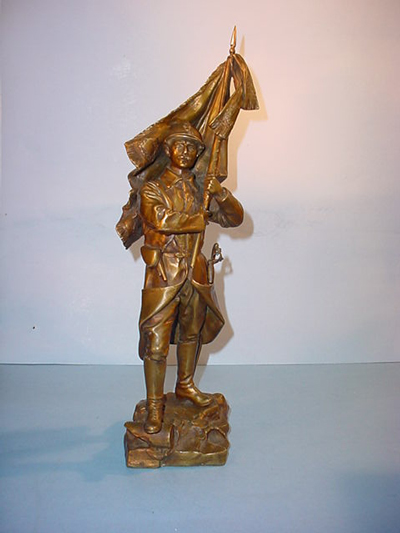
|
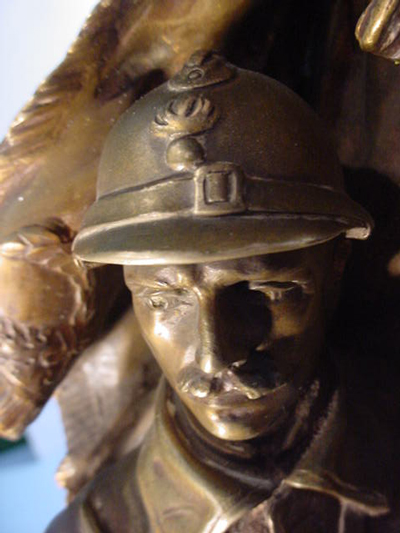
|
|
A Bronze Figure of a French Soldier with Standard (World War I) (Item FRAN 4-4)
|
||
|
DESCRIPTION: This bronze sculpture is magnificent in its patriotic depiction of a “Poliu” officer. The detail is wonderful and prodigiously accurate. The statue stands about a foot high and is signed G. Saulo. This was George Ernest Saulo, one of the greatest sculptors of military art in the 19th century. He also sculpted many feminine figures depicted in the nude. This statue we offer here is nothing short of great. It depicts a hope of Glory that was won in WWI and dashed to the ground in WWII by Hitler’s Wehrmacht 1940. The soldiers of WWI France were, with a few exceptions, not Napoleon's Old Guard. The Grande Armee was past tense, but don’t tell this guy that we offer here anything like that. His love for l’Belle France is obvious. At the end of the day this is truly a really fine art piece. Absolutely museum quality! It should be featured all by itself in a lighted glass showcase prominently displayed, it is actually that good. PRICE: SOLD |
||

|
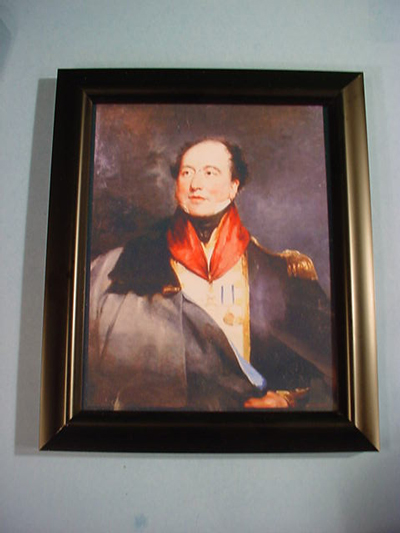 Captain Cole, Royal Navy |
|
A Beautiful French Hunting Cutlass Captured in Battle |
||||
|
DESCRIPTION: This is a wonderful museum piece (personified!). It is a French hunting sword that is bone and silver mounted, possibly dating back to the 17th century but could be as late as 1750. This weapon was captured by Captain Sir Christopher Cole of the British Royal Navy. Captain Cole was the skipper of the famed HMS Caroline and the Rippon, a 36 gun frigate in service against the French and earlier against the Dutch. The internet is replete with the adventures of Captain Sir Christopher Cole so we will not explore his illustrious career here at this time. He served as a Member of Parliament after his life of high adventures on the sea had ended. He had also served in the rank of Colonel in the Royal Marines. He was invested as a Knight Commander (Order of the Bath) (KCB) in 1814. The sword or hunting weapon that we offer was captured from a French Captain during Captain Cole's many daring sea engagements. The style of hunting sword is longer than the usual and quite fancy indeed. Why would a French Captain be armed with a hunting sword instead of a naval sword? This is a speculative question but it can be supposed that it was a family heirloom and probably from a family of aristocracy as this weapon was obviously made by a swordsmith of the ‘master craft.’ The beauty of it is obvious. And please pay attention to the standing Turk on the blade that is commenserate with the memory of Prince Eugene of Savoy who defeated the Turks at the Battle of Vienna. Prince Eugene was born in Paris and was a hereditary Prince of the Royal House of Savoy. The French had a love/hate relationship with the Turks and Muslims, using them as allies from time to time but also fighting them in other eras. But many of the weapons of Austrians, Hungarians and the French often depict a fierce Turk in the blades of especially these styles of hunting weapons. The shape and style of the sword is very Islamic looking and this was favored by the French noble classes. We earnestly believe the French Captain who surrendered to Captain Cole was of French gentry at least, and Capt Cole treasured the sword enough that he had his name and R.N. (Royal Navy) engraved under the cross guard. (Shown in our pictures). We also believe this to be more than likely a mid-17th century sword (maybe 1650 or so.) It is of sword length -- 31" long in its scabbard. The beautiful silver decorative plaques that lie upon the gorgeous bone grips stand out boldly. The silver fittings on the scabbard are at some places repaired with silver overlay -- the scars of battle? Probably! The blade is about 21 ½" long and except for some old antiqued rust spots, it is quite excellent for its age and past usage. It would be rated as (museum grade excellent) and for a weapon of this age to have its leather and wood scabbard still there and fine is the incredible bone grip, but it has the minute age cracks to be expected on a weapon as old as this one. Back to the blade... it has about 8 engraved pictographs including the Turk. Some of the engraved parts at the base of the blade where it meets the cross guard are quite worn indicating that it was drawn often and used possibly through the many years. This was not the weapon of any peasant or even a lower class noble; it was surely the property of a highly placed Royal personage or at least fabulously wealthy landed gentry. It’s a superlative weapon worthy of display in the finest museum or very advanced collection. We have handled many fine pieces at Germania but this one is worthy of bragging about. A sword of elegant beauty but also it has the distinction of having belonged to a French officer and an illustrious British sea-going Knight of the Bath and M.P. Fantastic! PRICE: SOLD |
||||

|
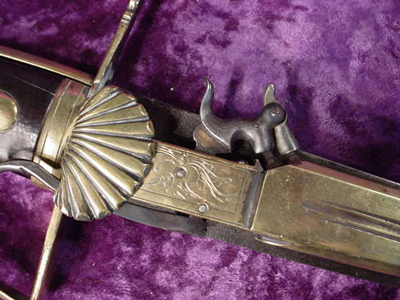
|
|
French Double Barrel Combination Weapon (Pistol & Sword) (Item FRAN 4-6 & KWEP 4-10 & HUNT 8-2)
|
|
DESCRIPTION: This is a true rarity deserving of the cover of a prestigious gun magazine perhaps? A combination sword or dagger & gun. These combination weapons are scarce enough but to find one with an over and under pistol as the accoutrement is “super rare.” It constructed with all brass fittings and the grip looks like a Napoleonic Sword of the cavalry regiments with horn grip or perhaps it is ebony? The brass guard supports a lion or panther head at the top. The brass clamshell hand guard covers part of the flint lock action. It has a very unusual trigger device as well. The piece was made probably by a professional weaponry blacksmith shop. It is signed by the maker in Paris. The action is inventive and very different. In one of our pictures supplied herein you can see the percussion hammer and if you look closely you can see that it has two strikers -- one top and one on the bottom. You can also see two nipple posts where the percussion caps are placed. When the first barrel is fired, the shooter can then in turn swing the hammer seen at the top downward thus enabling the hammer to strike the 2nd nipple post thus firing the 2nd barrel. Now and then these combination sword and gun ensembles are to be encountered in famous collections but never have we seen one like this. This example is prodigiously rare in the extreme! It probably dates in the 1860’s or earlier. Weapons such as these were used by hunters but also in warfare and also by police detachments. The piece may have had a scabbard but that is history. Another usage for something like this would be utilized in sea service either the kings navy or possibly by pirates? Perhaps that is why the fittings are brass that is less likely to be affected by the damp sea atmosphere. In that case it would not have a scabbard -- rather it would be stowed in the Captain’s cabin as a ready weapon to be used in the case of a possible mutiny. The possibilities are numerous but surely romantic saga has attended this magnificent double purpose sword. Of this we can only speculate but we can be assured that is a worthy museum piece that should be in a great collection. Details: 30 inches long overall, blade 24 inches, the double barreled pistol is 6 inches long, the grip with the clamshell guard is 7 inches long. PRICE: SOLD |
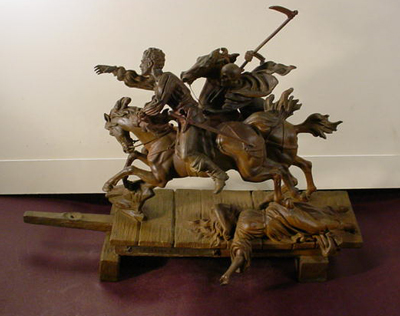
|
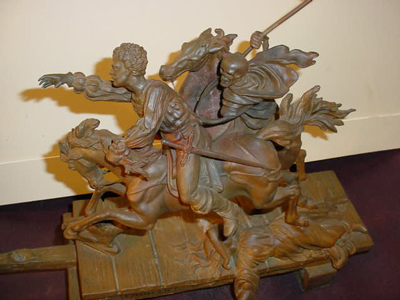
|
|
Incredible Statuary Grouping Taken from a French Army HQ in 1940 (Item FRAN 4-7 & WEHR 32-1) |
|
DESCRIPTION: This is a wonderful sculpture executed in iron that was a German officer’s trophy in WWII. We met the widow of this officer at an antique show in Stuttgart Germany last year and found out that she had this sculpture group. After the conversation with her we arranged to go to her apartment in Berlin a week later where we managed to negotiate and purchase it. It is a fantastic artistic sculpture that depicts a scene of morbid but romantically exciting sequence with three central figures and two horses. The piece was taken from a Field Headquarters connected to the Maginot line, Frances seemingly impenetrable defensive fortification. The sculpture was on a desk that was used by a Commanding officer in what was referred to as a ‘Petits Ouvrages’, a small adjacent fortress compound that reinforced the line of infantry bunkers that served for barracks, electric generator centrals, mess halls and officers’ quarters. After the German onslaught that ran over all French defenses in a matter of days in May of 1940, it is presumed that the unexpected happened so quickly that the French officer fled with practically none of his personal possessions other that the clothing on his back. Our German officer felt this was a fine trophy of war and he obviously did not sling it into a field pack (note: condition!) He carefully hauled it off to Paris and after packaging it very carefully he sent it intact to his wife in Berlin. The subject is noted on a plaque at the bottom of the base: La Chasse a La Fortune – this translates to roughly – ‘Hunting for Fortune’. To try to make sense of this statement can only be extrapolated by viewing the subject. (Suggestion) We have what looks to be a military man on horseback fleeing for his very life from the also mounted Grim Reaper who bears a great scythe and seeks to cut our hero down with it. Lying on the base is the figure of an obviously deceased maiden whose lifeless arm extends over the planks or base. (Artistic excellence!) (Theory) Could this in its depiction demonstrate the fortunes of greed? Could this cavalier have lost his lover through his quest for fame and fortune and now flees from the just retribution that is now at hand? Would you have a better theory? In any case, it is a most unusual subject and very possibly it is entirely unique. We have studied and merchandized bronze and iron sculptures for many years in America and in Europe but never seen anything like this. Cast iron figures are just as popular as bronze and often better detailed. This is certainly an example of the finest in this art form. The base is 13 inches long. The base is made to depict a plank bridge with realistic looking boards joined together. The measurement of the figure is for instance 12 inches from the bottom of the bridge to the top of the cavalier's head. There is an extension of the base that extends out the front that has a hole in it. Why??? This stumps us completely. Was it a place for something additional? Or, was it part of the legend? Only the artist would know and he probably belongs to the ages. So dear collector, here is our chance to own something not only historically important but presumably unique and ascetically stimulating. PRICE: SOLD |
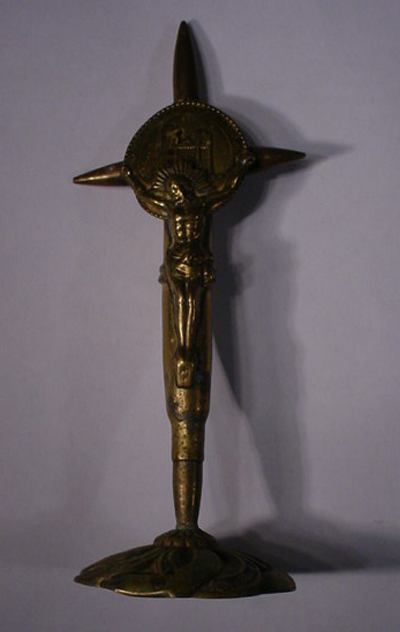
|

|
|
Crucifix Made from Bullets from WW 1 – Trench Art (Item FRAN 4-8 & WWI 12-12)
|
|
DESCRIPTION: From time to time one of these interesting items shows up. They are always unique since they are made in the field by soldiers or produced by jewelers in occupied territories from bullets supplied by these soldiers. This would appear to be the case here due to the professional touch to the base, The Christ figure, and the medallion. There was one on our site at WW1 6-15 and is still there however sold. This was a German one although the French were known to favor them as well as the British. The reason for them being produced by the soldiers is speculative. Some say it is an anti-war message that depicts religious imagery with the idea of the horrors of war (brother against brother) depicted with the debris of war and the same juxtaposition of the paraphernalia of death, with the obvious symbology of Resurrection. The one we offer could be a war souvenir from the war time effects of a German soldier who captured it from a French soldier or possibly it is in fact, the post war souvenir of a French soldier. The answer could be in the caliber and style of the bullets. We are not nomenclature experts when it comes to ammunition. In any case, they are in fact real bullets form the Great War period. Above the Christ figure is a medallion with the Cathedral of Reims Depicted. And the base is decorated with turning rays of the promise of eternity. The relic stands five inches high and the left to right bullet arms measure 2 ½ inches. A genuine piece of history from the war to end all wars. Too bad we didn’t learn from that! PRICE: $475.00 |
|
|
|
Signature of Napoleon Bonaparte on a Document from the War Department (Item FRAN 4-9) |
|
DESCRIPTION: Here is a great document that is from the 1st Empire Department of War. It has as its first wording at the top Au nom du
Peuple Français (“On Behalf of the French People”) and it’s the promotion of a Captain Daniel Freylag to a higher rank. Listed in columns are his
details of service and his campaigns, (actions). It’s signed by the Ministre de la Guerre (Minister of War) and also the Secretary for
the Premier Consul. Then across the middle of these two signatures written boldly is the signature of Napoleon. (He writes Bonaparte).
The signatures have faded to a light-brown texture over the centuries, but are still clear enough to discern. I cannot find a date; perhaps it
is written out as in most English comparable documents as “in the year of our Lord,” but I couldn’t make it out. At the heading of the paper is
the symbol of the Republic of France—the seated La Belle Française. This was used by Napoleon Bonaparte as 1st Consul of the French Republic,
so the document had to be after 1799 and before 18 May 1804, when he was proclaimed Emperor. The document is in excellent shape and is
professionally matted. Inside the frame is a nice picture of Napoleon. The frame measures 22 x 20 inches, while the document is 12 ½ x 9
inches. The picture of Napoleon is 8 ½ x 6 inches. All in all, it is one great historical offering of vast historical importance to a museum or
collector; a genuine relic of that age of high adventure and military grandeur. (Unfortunately, also a horrible fratricidal and tragic waste
of the finest men of the Aryan world of the time.)
PRICE: SOLD |
|
|
|
|
|
|
Napoleonic Sword from Egyptian Campaign (Item FRAN 4-10) |
|
DESCRIPTION: First Empire Napoleonic Sword from Napoleon Bonaparte’s Egyptian Campaign
We are very proud to offer this magnificent sword. It is possibly the most beautiful and historically important weapon we have ever offered. It is one of the very special swords that Napoleon presented directly to his generals after the Egyptian Campaign. On May 19, 1798, Napoleon and several senior scientists and military officials arrived in Alexandria, Egypt. On July 1, 1798, when the directive to invade Egypt came down Napoleon saw it as an opportunity to make the founding country of Western culture a province of the greatest country in modern Europe and he wanted to bring a gift–modern science–to help the Egyptians map their country, manage the Nile, raise their agricultural and industrial output, improve their standard of living, and invigorate the intellectual climate. Accordingly, he brought his bevy of soldiers and officers and he decided to take with him a corps of scholars trained in engineering, astronomy, natural history, topography, manufacturing, and linguistics. So, it can be said that the invasion of Egypt was not undertaken to capture Egyptian soil, but Egyptian culture and history and while the military invasion was an ultimate failure the scholarly one was successful beyond anyone’s expectations. Meticulous topographical surveys were made, native animals and plants were studied, minerals were collected and classified, local trades and industry were scrutinized, and most famously, ancient Egypt was discovered: Temples and tombs of Luxor, Philae, Dendra, and the Valley of the Kings. Each of these sties was measured, mapped, and drawn, recording in meticulous detail a Pharaonic Egypt never before glimpsed by the outside world. Over the years concluding in 1828 the first volumes with all the research (a total of 23 volumes) would appear. Three of these were the largest books that had ever been printed standing over 43 inches tall and they captured Egyptian culture from every possible vantage point. The most impressive were surly the volumes of antiquities, spilling over with obelisks, colossi, temples, sphinxes, and all manner of artifacts. But, the volumes on natural history were also impressive with their crocodiles, asps, lotuses, and palms. Never before had a single country inspired such a monumental encyclopedia of such depth and splendor. As to the invasion Napoleon landed in Egypt with 400 ships and 54,000 men and he proceeded to invade the country as he had recently invaded Italy, but, as we have illustrated, this invasion was decidedly different in the fact that he brought along the 150 ‘servants’ for social betterment and important research. So, in essence, the man who was called the Monster by other Europeans did in fact do something very positive in this instance. Because of this campaign he became wildly popular with the French people. Little did they know, however, that even at this time he was beginning the preparations for the proposed invasion of England, but that is another story. There was fierce fighting in the Egyptian campaign including the Battle of the Pyramids that ended with a French victory over an enemy force of about 25,000 Mamluks. In all, 300 French and 6,000 Egyptians were killed. The battle gave rise to dozens of stories and drawings. The Sword The magnificent sword is possibly the jewel of Napoleonic weapons as vastly important as the Egyptian campaign was to Napoleon and France. There needed to be a very special prize constructed to award the participants, thus Bonaparte went to one of the finest sword makers in France; a man to whom swords was equal to Boutet, who was Napoleon’s gun maker. This could have been Jean le Pale, who produced the finest in weaponry/guns/swords. He was the Royal gun maker to the French King Louis XVI and after the revolution, to Napoleon. The sword has a grip that features double-sided panels of mother of pearl with separate side panels of brass that are seen as open with palm-leaf design done in the manner of elegant jewelry. In the center of the grip on both sides is an escutcheon depicting an Egyptian pharaoh and this marks it as being a gift to a member of the Institute d’Egypte and all of the artists, scientists, and Napoleonic generals who accompanied him to Egypt were members and it was to them that the special swords were given. There were several designs, but all bore the pharaoh motif. The finest and most luxurious of them were to the generals and this one is surely one of them. The blade is of the style with incurved diamond-shaped triangular cutting edges (a very lethal rapier). This is why we feel this one was presented to a military recipient. It has brilliant beauty, but is also ready to function as a sword, as well. The clamshell languet is highly decorated with a face of an Amazon-like figure mounted upon it surrounded by mythical griffins whose heads emerge stretching outward from their winged bodies. All the decoration is separately adhered in the style associated with the finest of jewelry. The gilding is very bright and one would almost feel that they should put on gloves when handling the sword (It’s that nice!). It measures 38 inches long including the grip. The blade is 32 inches long. Unfortunately, the scabbard is missing. Here is one of the greatest First Empire Napoleonic swords found. We know of only one other that is in a private collection in France and that is in the collection of Y. Guinhut, who owns the Antik-Costume Company in Dinard, France. (contact@antikcostume.com) they handle the finest of Napoleonic reproductions, but Mr. Guinhut has a private collection of original period weapons. This sword should be in a museum or in a notable collection. Germania strives to handle only the finest and most rare of antiquities at all times. PRICE: SOLD |
|
|
|